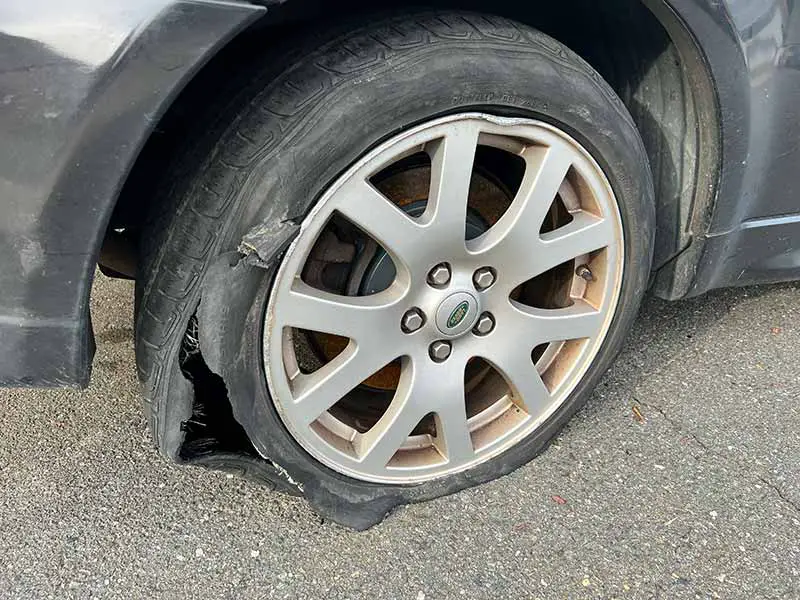You’re cruising down the highway when suddenly, the steering feels off, and there’s a thumping sound you can’t ignore. Flat tires are more than an inconvenience; they’re a disruption to your day and a hazard to your safety.
Flat Tire Statistics
In the U.S., drivers experience over 220 million flat tires every year. Tire-related issues account for around 33,000 accidents, including approximately 19,000 injuries and over 500 fatalities annually.
It’s not a matter of “If” but “When”. Drivers experience flat tires on average once every five years emphasizing the importance of proper tire maintenance and safety.
In this article, we delve into the world of flat tire statistics, from annual occurrences to the role they play in road safety. We’ll guide you through NHTSA tire replacement guidelines, common causes of flat tires, and essential tire safety tips. Finally, we provide a step-by-step emergency guide on what to do when you have a flat tire.

Flat Tire Statistics
Tires are quite literally where the rubber meets the road, and understanding the frequency and impact of flat tires can help drivers appreciate the importance of tire maintenance. Let’s dive into some of the statistics that shed light on flat tire occurrences and related accidents.
Global and National Statistics on Flat Tires
- General Flat Tire Statistics: Every driver will likely experience a flat tire at some point. It’s estimated that drivers encounter flat tires at a rate of up to three times every five years. This might not seem like much, but when you multiply this by the number of drivers worldwide, the numbers are quite significant.
- AAA Flat Tire Statistics: The American Automobile Association (AAA) reports that they respond to millions of flat tire calls annually. It’s one of the most common reasons for roadside assistance calls, highlighting the prevalence of this issue.
- Annual Flat Tire Incidents: It’s estimated that in the U.S. alone, there are over 220 million flat tires annually. This equates to seven tire punctures every second throughout the year, painting a picture of just how common this issue is.
Tire-Related Accident Statistics
- General Accident Data: Tires are a critical component of vehicle safety, and their failure can lead to serious accidents. It’s reported that tire issues contribute to a significant percentage of vehicular accidents.
- Tire Blowout Statistics: Blowouts can be dramatic and dangerous. The National Highway Traffic Safety Administration (NHTSA) notes that tire blowouts result in tens of thousands of accidents and numerous fatalities each year.
What These Numbers Mean
While these statistics may seem daunting, they serve as a reminder of the importance of regular tire maintenance and monitoring. Most flat tires and blowouts are preventable with proper care and awareness. By understanding the prevalence of tire issues, drivers can be more proactive in their vehicle maintenance, potentially reducing the risk of tire-related accidents and inconveniences.
Understanding Tire Safety and Maintenance
Keeping your tires in top shape is not just about avoiding the inconvenience of a flat; it’s about ensuring your safety and the longevity of your vehicle.
Let’s break down the essentials of tire safety and maintenance, focusing on replacement guidelines, common causes of flat tires, and what leads to those dreaded blowouts.
NHTSA Tire Replacement Guidelines
Proper tire maintenance isn’t just a good practice; it’s crucial for your safety. The National Highway Traffic Safety Administration (NHTSA) provides guidelines that help you understand when it’s time to replace your tires:
- When to Replace Tires:
- Tires should generally be replaced every 6 years, regardless of tread wear.
- Replacement is necessary when the tread is worn down to 2/32 of an inch.
- Signs of Tire Wear and Damage:
- Look out for visible tread wear indicators, bulges, or other visible damage.
- Regularly check tire pressure, as underinflation can lead to wear and tear.
Most Common Causes of Flat Tires
Understanding what commonly causes flat tires can help you avoid them:
- Road Hazards and Conditions: Potholes, sharp objects, and debris are the usual suspects.
- Improper Maintenance or Installation: Incorrect tire pressure, not rotating tires, or improperly installed tires can lead to issues.
The number one cause of tire blowouts is under-inflated tires
Leading Cause Of Tire Failure
Tire Blowout Causes
A tire blowout is sudden and often dangerous. Knowing what leads to blowouts can help you prevent them:
- Under-inflation: The number one cause of tire blowouts is under-inflated tires.
- Overloading: Exceeding your vehicle’s weight limit puts extra stress on tires.
- Heat: High temperatures can cause the air inside tires to expand, leading to increased pressure and potential blowouts.
- Wear and Tear: As tires wear down, they become more susceptible to damage and failure.
The Bottom Line on Tire Safety
Tire safety is an integral part of vehicle maintenance that should never be overlooked. Regular checks and understanding the basics of tire health can drastically reduce the chances of flat tires and blowouts.
Investing a little time and effort into maintaining your tires not only ensures a smoother ride but also protects you, your passengers, and other road users.

Tire Safety Checklist
Ensuring your vehicle’s tires are in prime condition is crucial for safe driving. Here’s a comprehensive tire safety checklist that’s easy to follow and will help keep your tires in optimal condition, minimizing the risk of flat tires and blowouts.
Regular Maintenance Tasks
Keeping up with these tasks will extend the life of your tires and enhance your vehicle’s performance and safety.
- Checking Tire Pressure:
- Check at least once a month and before long trips.
- Ensure they are inflated to the vehicle manufacturer’s recommended levels.
- Inspecting Treads and Sidewalls:
- Look for signs of wear, tears, or bulges.
- Use the “penny test” to check tread depth; if you can see the top of Lincoln’s head, it’s time for new tires.
- Rotating Tires:
- Rotate every 6,000 to 8,000 miles to ensure even wear.
- This can extend the life of your tires and improve performance.
Seasonal and Usage-Based Considerations
Different conditions require different considerations for your tires. Be mindful of these to adapt accordingly.
- Adjusting for Weather and Road Conditions:
- Consider winter tires for snow and ice.
- Increase inspections during extreme temperatures as they can affect tire pressure and condition.
- Special Considerations for Trucks vs. Passenger Cars:
- Trucks might require different tire types and care due to heavier loads and different usage patterns.
- Ensure you’re using the right tires and maintaining them according to your vehicle’s specific needs.
The Importance of Being Proactive
A well-maintained tire not only saves you from the inconvenience of flat tires or blowouts but also ensures optimal fuel efficiency and safer driving conditions. It’s much better to spend a little time regularly to check and maintain your tires than to deal with the consequences of neglect.

What To Do When You Have a Flat Tire
Encountering a flat tire can be a stressful and potentially dangerous situation. However, with the right knowledge and steps, you can handle it safely and efficiently. Here’s a step-by-step guide on what to do when you experience a flat tire.
Step-by-Step Guide on Handling a Flat Tire
Being prepared and knowing the proper steps can significantly ease the stress of dealing with a flat tire.
- 1. Stay Calm and Find a Safe Location:
- Keep a firm grip on the steering wheel.
- Slow down gradually and scan for a safe, level place to pull over.
- 2. Turn On Your Hazard Lights:
- Alert other drivers of your situation by turning on your hazard lights as soon as you realize you need to stop.
- 3. Apply the Parking Brake:
- Once stopped, apply the parking brake to prevent your vehicle from rolling.
- 4. Assess the Situation:
- Check for traffic before exiting your vehicle.
- Ensure it’s safe to proceed with changing your tire.
Who to Call When You Have a Flat Tire
Sometimes, it’s best to call for professional help, especially if you’re not comfortable changing the tire yourself or if you’re in an unsafe location.
- 1. Emergency Services and Roadside Assistance:
- Have phone numbers for emergency services and roadside assistance readily available.
- Many insurance policies offer roadside assistance coverage.
- 2. Importance of Having a Spare Tire and Tools:
- Ensure you have a functional spare tire, jack, and lug wrench in your vehicle.
- Regularly check the condition of your spare tire.
Final Tips for Handling a Flat Tire
- Don’t Drive on a Flat Tire: Driving on a flat can cause further damage to the tire and your vehicle. It can also be dangerous.
- Practice Changing a Tire: Familiarize yourself with your vehicle’s jack, spare tire, and the process of changing a tire in a controlled environment.
Resources
While I am unable to browse for specific resources currently, typical reputable sites for tire safety information include:
- Tire Maintenance & Safety Tips – NHTSA
- Understanding Tire Safety and Maintenance – AAA
- Tire Safety: Everything Rides On It – SaferCar
Final Thoughts
Understanding flat tire statistics and adhering to a tire safety checklist is not just about avoiding the inconvenience of an unexpected stop; it’s about ensuring a safe and efficient journey every time you hit the road.
Regular tire inspections, understanding the causes of tire wear and tear, and knowing what to do in an emergency are key to your road safety. Keep these tips in mind, stay informed, and take proactive steps to maintain your vehicle’s tires.
Good luck and happy motoring.




